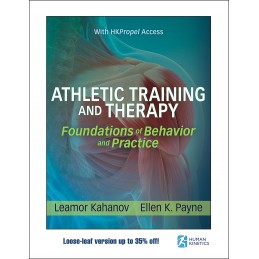Athletic Training and Therapy:: Foundations of Behavior and Practice builds upon an undergraduate understanding of health and exercise sciences to instill an evidence-based, graduate-level knowledge of best practices in athletic training and health care. This text integrates essential competencies outlined by the AT Strategic Alliance, a collaboration of the National Athletic Trainers Association (NATA), Board of Certification (BOC), and Commission on Accreditation of Athletic Training Education (CAATE).
Athletic Training and Therapy highlights contemporary concepts not often found in other introductory texts, such as cultural literacy, interprofessional practice, preventative health care, administrative management, special populations, and epidemiology. Students gain a complete picture of their role as an athletic trainer as they explore these topics and progress through the text.
Part I covers foundational clinical competencies that will guide students in their future professional practice. Part II features holistic wellness concepts and proactive strategies to prevent illness and injury. Part III presents emergency interventions for acute injury and immediate care. Part IV offers information on evaluating illness and injury. Part V addresses therapeutic and medical interventions, including therapeutic exercises, pharmacology, and casting procedures.
The full-color text engages students and fosters comprehension with learning aids::
- Evidence-Based Athletic Training sidebars that highlight a position statement, systematic literature review, or high-level randomized control trials
- Foundational Skills sidebars that provide step-by-step instructions for common skills required of entry-level athletic trainers
- Chapter summaries of key concepts
- Learning objectives to help students focus their studies during their graduate education and during preparation for the BOC examination
- Related digital content delivered through HKPropel:: videos of select skills and techniques, gradable chapter quizzes, case studies with critical thinking questions for each chapter, check sheets that can be used to grade students on their ability to accurately perform foundational skills, and flash card activities to self-test on glossary definitions
Athletic Training and Therapy offers advanced athletic training students an engaging presentation of the clinical skills they will need as a successful member of the interprofessional health care team.
Note:: A code for accessing HK
Propel is included with all new print books.




 Delivery policy
Delivery policy
 Security policy
Security policy
 Return policy
Return policy
